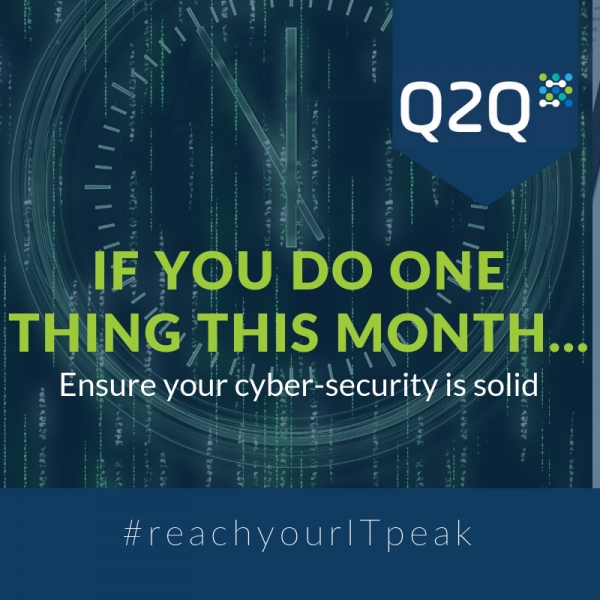If you do one thing this month… Ensure your cyber-security is solid
Now, the topic of cyber-security – and the importance of it – is nothing new to the business scene. But despite SMEs knowing that effective defence mechanisms are crucial to help protect against cyber-attacks and hacking attempts, many still don’t have the optimum level of protection for their business.
And, with two thirds of SMEs – or 67% – being more concerned about cyber-threats now than they were 12 months ago, it goes without saying that it’s worth investing the time and effort into safeguarding your systems from a dreaded hacking or data breach situation.
While anti-virus software plays a key role in preventing pesky attacks from happening, unfortunately this alone will not conserve your SME’s cyber-safety – there’s a lot more to it than that…
So, if you do one thing this month, ensure your cyber-security is as strong as it can possibly be. We’ve put a few steps together to help you along the way!
Did you know that one size doesn’t fit all?
As part of our recent campaign – #reachyourITpeak – we created lots of content and resources to support UK SMEs in identifying their unique IT requirements, and help them progress to the next level of their IT journey.
It goes without saying that a business in its start-up stages will undoubtedly have different needs to that of an established SME – and if you can remember this, you’re halfway there!
The pivotal message here is not to get complacent with the software and hardware you’ve already got in place, because although it may appear like it’s working seamlessly now, the evolution of sophisticated cyber-threats means it won’t stay safe for long. And no business can afford to be left behind in today’s whirlwind of advanced technologies.
So, no matter if you’re beginning your journey in the corporate world, or you’re a well-seasoned, growing SME, it does the world of good to take a step back and get a comprehensive audit of your current systems and their protection status. It’s only once you know what you’re working with, that you can implement effective measures that really work.
Where’s your cyber-security policy?
“My what?” is often the response we hear to this question. In order to achieve the buy-in from your employees – and so they know what’s expected of them – it’s vital you have a clearly defined cyber-security policy.
Depending on the nature of your organisation, this document may be formal or informal, but one thing it should be, is transparent.
Simply telling your employees on an ad-hoc basis – in a meeting or over lunch – that they shouldn’t be opening emails with attachments unknown senders, reiterating the importance of reporting any suspicious websites, or educating them on the kinds of cyber-attacks that are out there and how to recognise them, won’t work.
A documented policy allows you to inform and remind people about the above, as well as communicate best practice too!
When did you last meet with your employees?
Because the threat landscape is hurtling forward at a rapid rate, regular check-ins with your team are part and parcel of a successful, long-term cyber-strategy.
Whether it’s biannual training courses or modules, or even in-house refresher briefings with feedback forms, you should be integrating cyber-awareness into your day-to-day business workings. Once colleagues are up-to-speed and conscious of the IT issues facing your business, only then will they stop being one of your firm’s biggest cyber-security threats.
Do you have remote workers?
Quite often, modern SMEs offer flexible working to their staff, and while this is great for being able to stay connected at all times, it’s not very beneficial to a business if it isn’t done safely.
In a recent post, we covered the importance of setting up a Virtual Private Network for those who work on-the-go, but if your SME relies on public Wi-Fi hotspots, this is a dangerous gateway for hackers to access your system.
This comes back to our earlier point that your cyber-security measures should reflect what your business needs on both a practical, operational level. So, if that’s secure access for remote workers, or encrypted devices and folders, it’s critical that you have this in place.
The minefield of cyber-security best practices and checklists are never-ending, so when doing your one thing this month, bear in mind the uniqueness of your business and give your IT the time and attention it deserves – it’ll pay dividends in the long run!
If you’d like to know whether your SME’s current cyber-security is solid and what you can do to further enhance it, why not have a chat with one of our friendly Q2Q experts?



